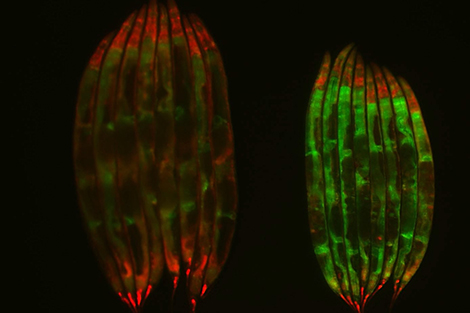Uncovering a ‘smoking gun’ in age-related disease

Old C. elegans expressing a specific alternative splicing event tagged by either green or red fluorescent protein, well-fed (left) or on dietary restriction (right). Worms on dietary restriction maintain a youthful splicing pattern (as seen in young worms) compared to the well-fed worm population at the same age./ Image: Caroline Heintz
Aging is a key risk factor for a variety of devastating, chronic diseases, yet the biological factors that influence when and how rapidly cells deteriorate over time remain largely unknown. Now, for the first time, a research team led by Harvard T.H. Chan School of Public Health has linked the function of a core component of cells’ machinery — which cuts and rejoins RNA molecules in a process known as “RNA splicing” — with longevity in the roundworm. The finding sheds light on the biological role of splicing in lifespan and suggests that manipulating specific splicing factors in humans might help promote healthy aging.
The study was published in the Dec. 5, 2016 advance online issue of Nature.
“What kills neurons in Alzheimer’s is certainly different from what causes cardiovascular disease, but the shared underlying risk factor for these illnesses is really age itself,” said William Mair, assistant professor of genetics and complex diseases at Harvard Chan School and the study’s senior author. “So one of the big questions is: Is there a unifying theme that unfolds molecularly within various organ systems and allows these diseases to take hold?”
Due to advances in public health, life expectancy has dramatically increased worldwide over the last century. Although people are generally living longer lives, they are not necessarily living healthier lives, particularly in their last decades. Age-related diseases such as cancer, heart disease, and neurodegenerative disease are now among the leading global health burdens — a problem that will likely only worsen.
Old C. elegans expressing a specific alternative splicing event tagged by either green or red fluorescent protein, well-fed (left) or on dietary restriction (right). Worms on dietary restriction maintain a youthful splicing pattern (as seen in young worms) compared to the well-fed worm population at the same age. Image: Caroline Heintz





